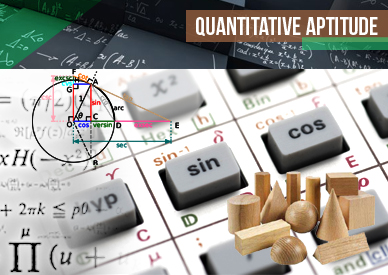Data Interpretation based on Profit and Loss
D.1-10) Refer to the following table and answer the questions.
(Assume cost price be Rs.100)
| Item |
profit |
loss |
Discount |
Marked price
(in Rs.) |
| A |
40% |
– |
30% |
– |
| B |
12% |
|
|
140 |
| C |
|
10% |
25% |
– |
| D |
12.5% |
|
|
200 |
| E |
|
17.5% |
|
120 |
1) what is the ratio between the marked price of item A and the marked price of item C?
a) 7 : 3
b) 4 : 5
c) 6 : 3
d) 4: 7
e) None of these
Click here to View Answer
(e) Let A’s cost price be Rs.100
Profit% = Rs.40%
So, selling price = Rs.140
Discount% = 30%
Marked price = 70% of X=140
=Rs.200
Let C’s cost price be Rs.100
Loss% = Rs.10%
So, selling price = Rs.90
Discount % = 25%
Marked price = 75% of X=90
=Rs.120
Required Ratio = 200 : 120 = 5 : 3
2) Item D’s discount rate is what percentage of item B’s discount rate?
a) 19.875%
b) 22.875%
c) 27.875%
d) 21.875
e) None of these
Click here to View Answer
(e) Let Item D’s cost price be Rs.100
Profit % = Rs.12.5
So, selling price = Rs.112.5
Marked price = Rs.200
“Discount rate =” ” 200-112.5″ /200 “×100= 43.75%”
Let Item B’s cost price be Rs.100
Profit % = Rs.12
So, selling price = Rs.112
Marked price = Rs.140
“Discount rate =” ” 140-112″ /140 “×100= 20%”
“Required percentage = ” 43.75/20 “×100 = 218.75%”
3) What is the discount rate of item E?
a) 41.25%
b) 31.25%
c) 27.08%
d) 22.75%
e) 30.75%
Click here to View Answer
(c) So, selling price = Rs.82.5
Marked price = Rs.120
“Discount rate =” ” 120-82.5″ /120 “×100= 31.25%”
4) What is the difference between total marked price of item A, B, C, D, E and the total selling price of item A, B, C, D , and E?
a) Rs.240
b) Rs.248
c) Rs.228
d) Rs.250
e) None of these
Click here to View Answer
(e) Item B’s marked price =Rs.140
Item D’s marked price =Rs.200
Item E’s marked price =Rs.120
Let A’s cost price be Rs.100
Profit% = Rs.40%
So, selling price = Rs.140
Discount% = 30%
Marked price = 70% of X=140
=Rs.200
Let C’s cost price be Rs.100
Loss% = Rs.10%
So, selling price = Rs.90
Discount % = 25%
Marked price = 75% of X=90
=Rs.120
Let’s cost price be Rs.100
Item A’s Profit % = 40%
So, Item A’s selling price = Rs.140
Similarly,
Item B’s selling price = Rs.112
Item D’s selling price = Rs.112.5
Item C’s loss % = 10%
So, Item C’s selling price = Rs.90
Similarly,
Item D’s selling price = Rs.82.5
Difference = (140+200+120+200+120 )- (140+112+112.5+90+87.5)= Rs.238
5) If Item A’s profit % is decreased by 20% and Item C’s loss % is increased by 20% then what is the approximate different between the marked price of Item A and C?
a) Rs. 63
b) Rs.73
c) Rs.65
d) Rs.60
e) None of these.
Click here to View Answer
(a) Let A’s cost price be Rs.100
Now A’s
Profit% = 20%
So, selling price = Rs.120
Discount% = 30%
Marked price = 70% of X=120
=Rs.170(approximately)
Let C’s cost price be Rs.100
Now C’s
Loss% = Rs.20
So, selling price = Rs.80
Discount % = 25%
Marked price = 75% of X= 80
=Rs.107( approximately)
Difference = 170-107= Rs.63
6) Rahul invested 20% more than Mohit. Mohit invested 10% less than Ragu. If the total sum of their investment is Rs.17880, how much amount did Raghu invest?
a) Rs.6000
b) Rs.7000
c) Rs.8000
d) Rs.5000
e) cannot be determined.
Click here to View Answer
(a) Let the investment made by Raghu be 100x, so Mohit’s investment = 90x and rahul’s investment =108x
108x+90x + 100x = 298x = 17880
X=60
So, Raghu investment = 100x = Rs.6000.
7) A, B, C and D are four salesman in the first month they received a commission of Rs.3200 from their company and divided it in the ratio of 2 : 3 : 4 : 7 in the second month the commission doubled, the amount was doubled in the ratio 3 : 4 : 5 : 4. In the third month the commission tripled when compared to the first month and they shared in the ratio of 4 : 7 : 3: 2 and in the fourth month the commission became half of the previous month and they shared it in the ratio of 4 : 3 : 5 : 4 . What was the average monthly earning of C over the period?
a) 1575
b) 1675
c) 1625
d) 1525
e) None of these
Click here to View Answer
(d) Total commission in first month = Rs.3200
Total commission in second month = Rs.6400
Total commission in thired month = Rs. 9600
Total commission in fourth month = Rs.4800
“C’s share in the commission =” 4/16 of 3200+ 5/16 of 6400+ 3/16 of 9600+ 5/16 “of 4800”
=800 + 2000 + 1800 + 1500 = Rs.6100
“C’s average monthly earnings = ” “6100” /4 “= Rs.1525.”
8) How many 6 digit numbers can be formed out of the number 542658, which are even?
a) 480
b) 720
c) 360
d) 5040
e) None of these
Click here to View Answer
(e) Unit place can be taken by any of the three even digits 2, 4, 6 and 8 and rest of the places can be filled up in 5!ways.
But since digit 5 occurs 2 times.
“Hence required number of numbers ” (4!×5!)/2! “= 240. “
9) Two shops A and B marked the same brand of jeans for Rs.900. Shop A offers successive discounts of 15% and 15% While shop B offers successive discounts of 20% and 10%. Then the difference in the selling price of jeans is?
a) Rs.2.25
b) Rs.3.35
c) Rs.4.45
d) Rs.5.55
e) None of these
Click here to View Answer
(a) Final selling price of jeans in shop A = (900- 900×0.15)- (900-900×0.15)×0.15 = Rs. 650.25
Final selling price of jeans in shop B = (900-900×0.20)- (900-900×0.20)×0.10= Rs.648
Difference = Rs.2.25
10) Let us assume that 20g of sugar dissolves in 100g of water. Even an extra pellet will remain undissolved and sediment at the bottom of the solution. Now, water starts evaporating from 1kg of 7% solution at the rate of 32.5g per hour. After how long will the sediments start to evaporate?
a) 25 hours
b) 20 hours
c) 15 hours
d) 30 hours
e) None of these.
Click here to View Answer
(b) Sedimentation occurs when more than 20g of sugar is present in 100g of water.
Amount of sugar in 1kg of water = 70g
“Amount of water needed for sedimentation to start = ” “70x×100″ /20 ” = 350g”
Amount of water that should evaporate = 1000-350 = 650g
“Time required for eveporation =” ” 650″ /”32.5 ” “= 20 hours.”




8 comments
There is a difference between ” increased by” and ” increased to”. If the original percentage is 30 %.
Increased to 40% means the answer is 40%.
Increased by 40% means it will be 70%.
So there may be correction in Ans 5 Explanation.
Kindly explain me if I am wrong.
you are right.
Keep going
Thank you Sir
Thank you so much for getting back. Apologies. my query was to question number 5. Kindly help on that as well
For Q6, how the loss percentage will be 20% if the loss percentage is increased by 20% from 10%. Please explain
Mohit invested 90x. rahul invested 20% more than Mohit. So his investment is 120*90x/100 = 108x
For q.3 the S.P is 82.5 for E because the loss is 17.5. Then how you calculated the S.p as 87.5
Ans updated. Thanks for Feedback